Seasoning is an essential first step when cooking with a carbon steel or cast iron wok. Here's a simple, step-by-step guide to help you season your new wok using just a few basic ingredients.
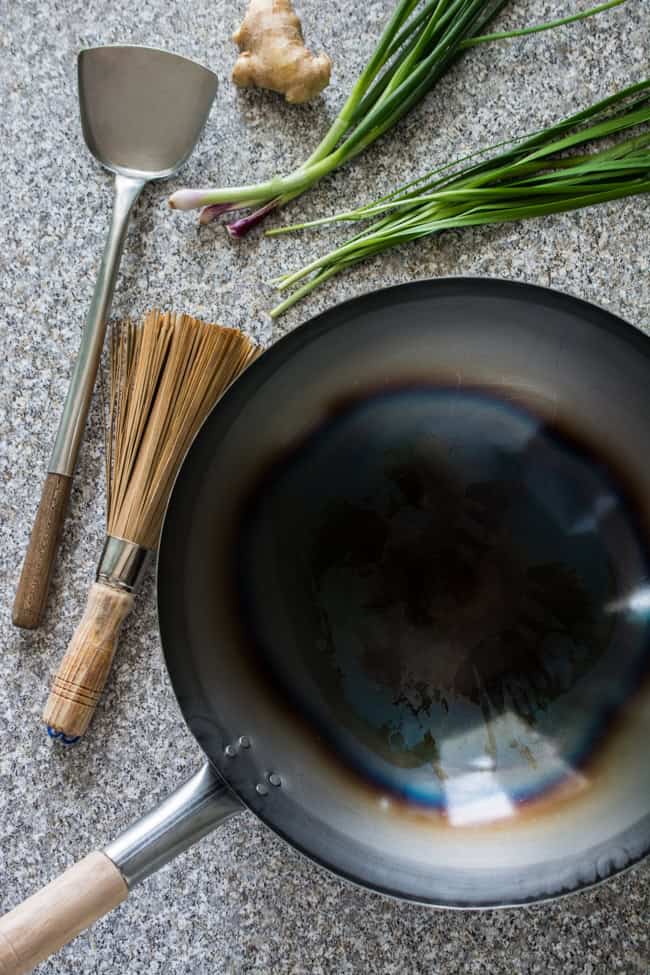
I bought my very first wok after moving from Malaysia to the United States to attend university in 2000. I had absolutely no clue what I was doing in the kitchen back then, but I was excited to try to replicate the dishes I grew up with.
After washing my brand-new carbon steel wok for the first time, I was shocked to find it completely covered in rust. I was so confused because my Mum's and grandmother's woks never rusted!
Thinking I had ruined it, I went back to the Asian supermarket to buy a new one. The store owner recognized me and refused to sell me another wok. Instead, he told me to go home, scrub off the rust, and season it.
I had no idea what that meant. So I called my mum, who explained that her wok stayed rust-free because it was so well seasoned from years of regular use. That’s when I learned how important seasoning is, and how simple it can be once you understand the process.
With the right care, a wok can last for generations. My Nanny’s (my paternal grandmother) wok was passed down to me, and I still treasure it today.
It’s truly one of the most versatile tools in the kitchen. This step-by-step guide will walk you through how to season your wok properly, so you can enjoy cooking with it for years to come.
⚠️ IMPORTANT: This step-by-step guide is specifically for carbon steel and cast iron woks. If you have a STAINLESS STEEL wok, you don’t need to season it the same way. Stainless steel doesn’t develop a patina like carbon steel does, and trying to season it won’t give the same results. Scroll down to the “Do You Need to Season a Stainless Steel Wok?” section for more information on this.
Why season a wok?
Seasoning a carbon steel or cast iron wok creates a thin, protective layer of oil that bonds to the surface through heat. This not only prevents rust but also helps develop a natural nonstick coating. Over time, repeated cooking builds up this layer into what’s known as a patina - a dark, slick surface that improves the more you use your wok.
You’ll notice your wok getting darker as the patina develops. That deep color is a good sign. It means your wok is building character and becoming more nonstick with each use.
Seasoning also helps bring out subtle flavors in stir-fry dishes. In Chinese cooking, this is part of what’s known as wok hei, or “the breath of the wok”; that slightly smoky, savory aroma you get when stir-frying over high heat.
What you'll need:
- A carbon steel wok or cast iron wok (either brand new, or due for re-seasoning)
- Liquid dish soap
- Scouring pad , stainless steel scrubber, or wok brush
- 3 tablespoons of cooking oil (must be high smoke point oil; I recommend peanut oil or grapeseed oil)
- 2-inch piece of ginger (thinly sliced)
- 1 ½ cups chopped scallions or garlic chives (or a mixture of both; cut into approximately 1-inch pieces)
- 2 - 3 paper towels
Step 1: Wash the wok thoroughly using a scouring pad or a stainless steel scrubber and a generous amount of dish soap.
All brand new cast iron and carbon steel woks have a layer of chemical or oils to prevent them from rusting before they are purchased.
I recommend scrubbing the wok at least two to three times to get rid of any factory chemical or oil residue as you would not want any of that in your food!
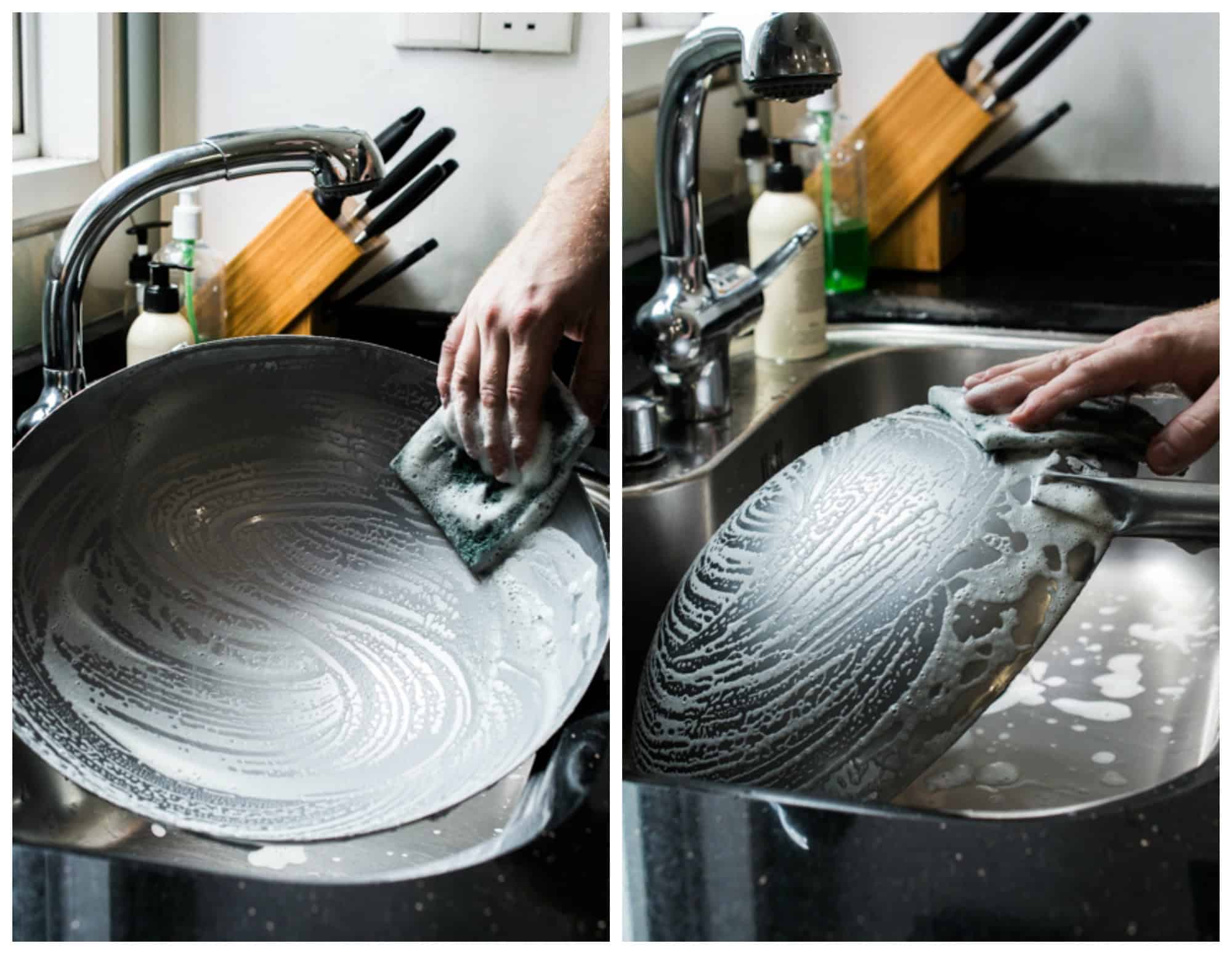
Step 2: After rinsing all the soap off the wok, let it drip dry for a few seconds, then place it on your stove over medium heat.
This will dry the wok and prep it for its first seasoning! After just a few moments, the bottom of the wok will start to turn a dark color with a blue-ish hue.
Don't be alarmed - this is totally normal! The more you use it, the darker the wok will become.
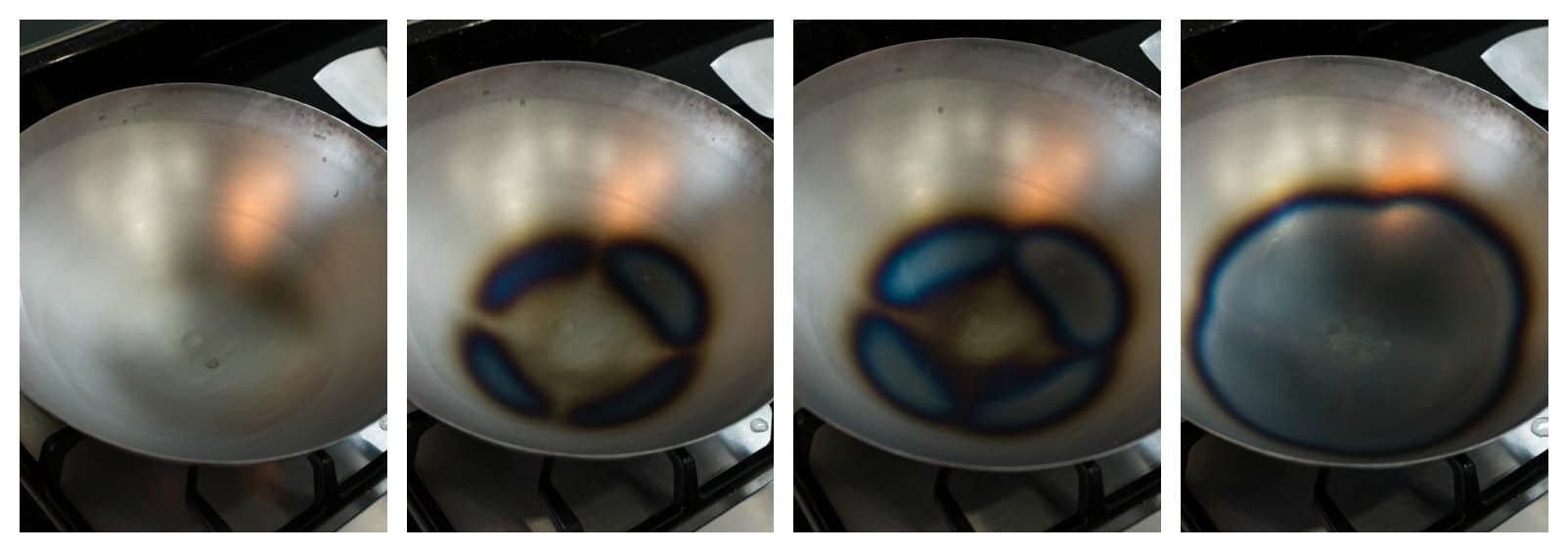
Step 3: As soon as you see the wok start to smoke just a little, add about 2 tablespoons of cooking oil. You can use any oil with a high smoke point. I recommend peanut oil or grapeseed oil.
Use your wok spatula to spread the oil around just the bottom part of the wok, then add sliced ginger (2-inch piece, sliced thinly), and about 1 ½ cups of chopped scallions or garlic chives (or a combination of both).
The purpose of adding these ingredients is two-fold: Not only do they add a wonderful aroma and patina to the wok, they also help to spread the oil evenly over the (inside) surface of the wok.
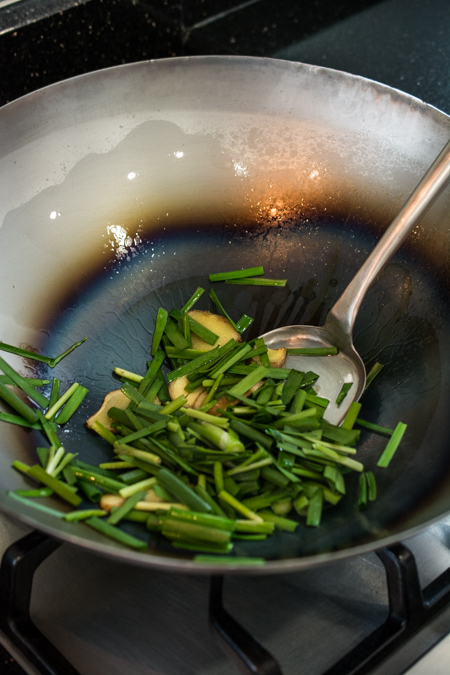
Step 4: Stir the aromatics gently but continuously, moving them around to coat the entire interior surface of the wok.
You don’t need to stir vigorously; just enough to keep them from burning while helping the oil spread evenly across the surface.
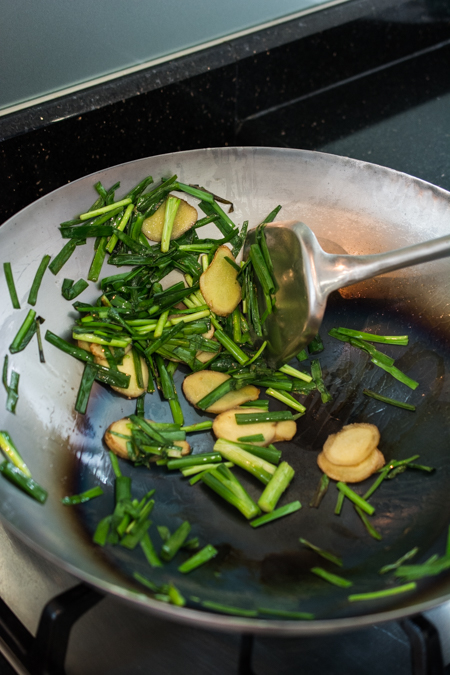
Step 5: Once the vegetables have started to char slightly, remove them from the wok and discard.
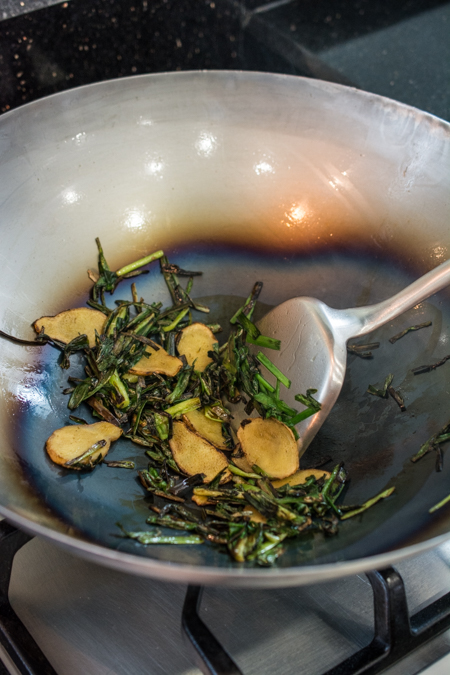
Step 6: Rinse the wok under running water. Use a wok brush, or stainless steel scrubber to remove the food residue from the wok. Do NOT use soap this time!!
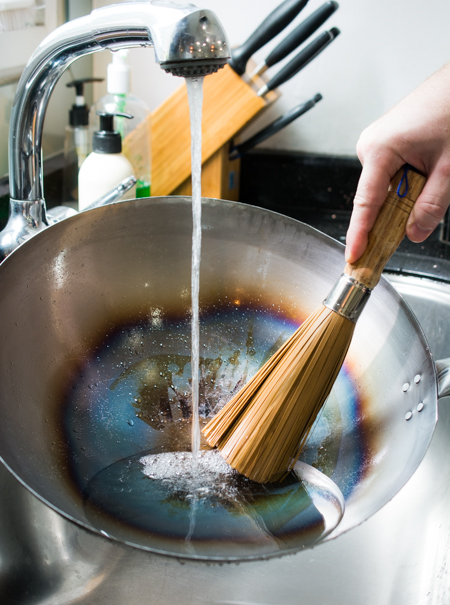
Step 7: Let the wok drip dry again, then return it to the stove over medium heat. Once it’s completely dry, turn off the heat.
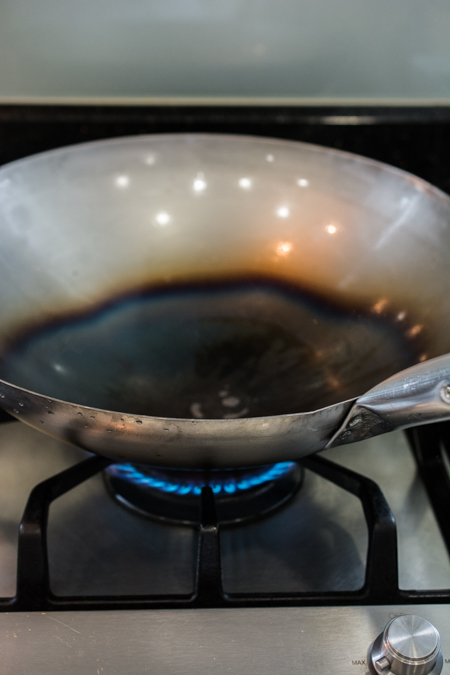
Step 8: After the wok has cooled slightly, pour about 1 tablespoon of cooking oil into the wok.
Would you like to save this?
Fold 2–3 paper towels and use them to carefully spread the oil into a thin, even layer across the inside surface.
Go slowly here to avoid splashing. Hot oil can burn if it hits your fingers (yes, I learned that the hard way!)
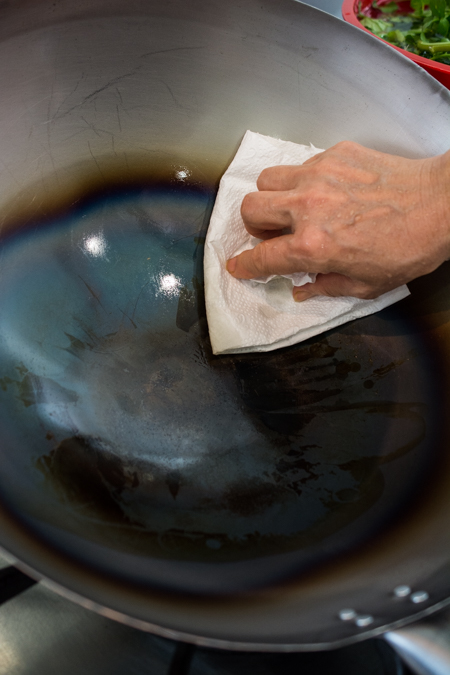
Here's a before-and-after comparison of my wok being seasoned for the first time:
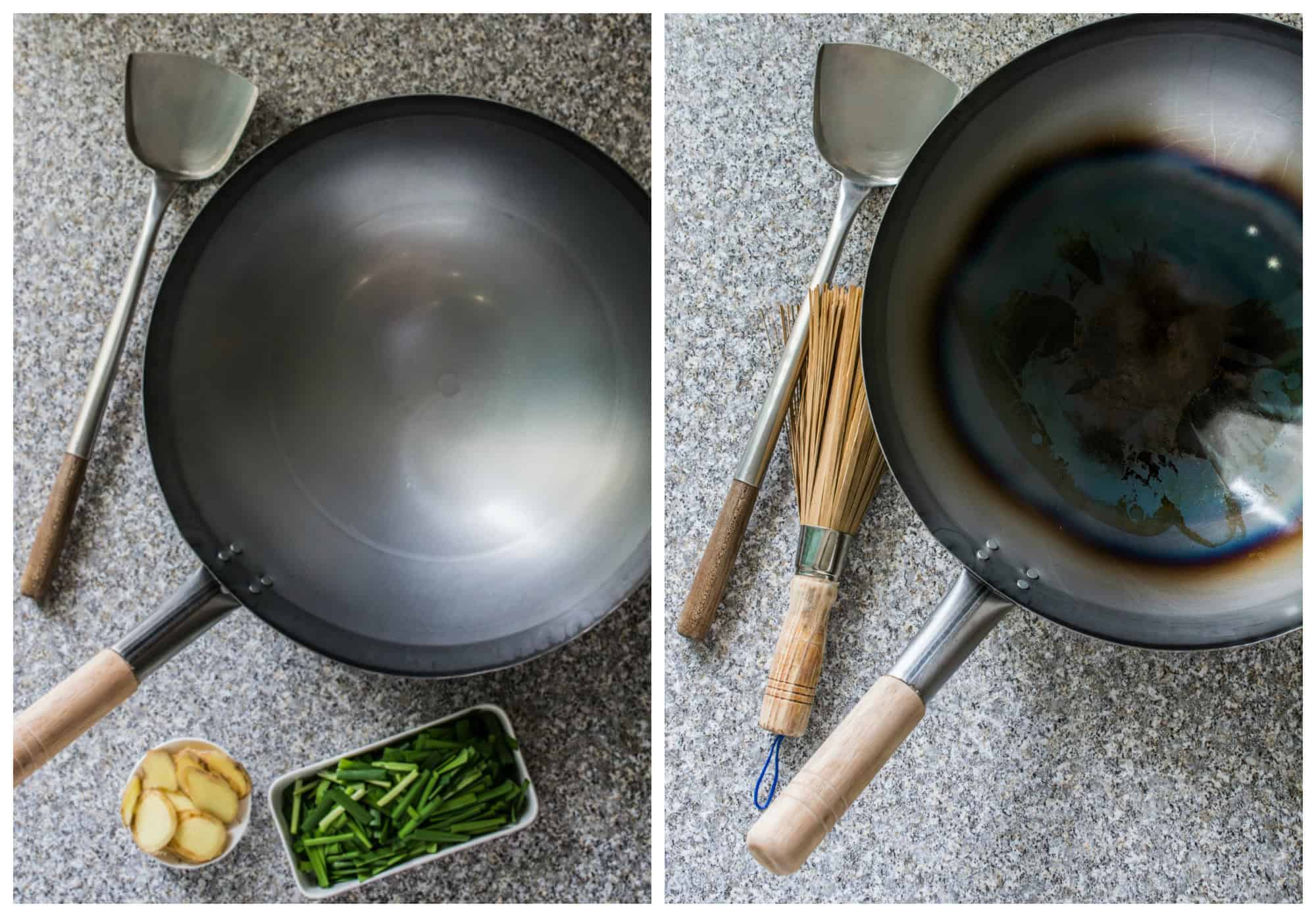
That's it! You've seasoned your brand new wok! You're ready to stir-fry! 🙂
UPDATE: Here's a photo of this same wok exactly 9 months after its first seasoning (2 - 3 times per week usage)

Maintaining Your Wok After Seasoning
After you’ve seasoned your wok for the first time, avoid using dish soap to clean it unless absolutely necessary (like after cooking something spicy and you need to cut through the chili oil).
You’ll also want to hold off on cooking acidic ingredients, such as tomatoes or vinegar-based sauces. Steaming or poaching too soon can strip away the fresh patina you just built. If that happens, don’t worry - you can always re-season using the scallions and ginger method.
After each use, rinse the wok with hot water and scrub it with a wok brush or scrubber to remove any food residue. For more stubborn bits stuck to the surface, your metal wok spatula works great for scraping them off.
Just don’t soak the wok - it's a surefire way to invite rust.
Don’t worry if your wok doesn’t turn jet-black right away. It takes time and regular cooking to build up that gorgeous, nonstick patina.
Eventually, you’ll be able to skip the post-use oiling step altogether. Until then, think of each stir-fry as one more layer in your wok’s seasoning journey.
Do You Need to Season a Stainless Steel Wok?
Seasoning a stainless steel wok isn’t necessary, and it won’t deliver the same long-term benefits as seasoning a carbon steel or cast iron wok.
Stainless steel is non-porous and smooth, unlike carbon steel or cast iron, which have tiny pores and a slightly rough surface that allow oil to bond and build up over time. When you heat oil in a carbon steel wok, it goes through a process called polymerization, where the oil transforms into a hard, slick layer that protects the metal and creates a natural nonstick surface.
That just doesn’t happen with stainless steel.
Even if you try to “season” a stainless steel wok, the oil stays on the surface instead of bonding with it. It won’t develop a patina, and any food residue left behind will simply burn or go rancid. Not exactly the kind of flavor you want to carry into your next meal.
That said, if you do have a stainless steel wok, you can use a technique called heat conditioning to help reduce sticking while cooking. It’s not true seasoning, but it can make a difference:
- Heat your stainless steel wok until a droplet of water sizzles and dances across the surface.
- As soon as all of the water has completely evaporated, add a small amount of oil and swirl to coat the base.
- Once the oil is shimmering, add your ingredients and start cooking.
Just remember: Stainless steel woks should be washed with soap after each use to remove any leftover oil or food residue, since nothing bonds to the surface and build-up can become unpleasant over time.
💡 Pro Tips for Wok Seasoning & Maintenance
Keep your oil in a squeeze bottle or spray bottle
It makes it so much easier to add just the right amount of oil when re-oiling your wok after use.
Avoid steaming, boiling, or cooking acidic dishes early on
Tomato sauces, vinegar, and even poaching water can strip away your fresh seasoning. Save those recipes for when your wok has a more established patina.
If your wok starts to look patchy, don’t panic
Uneven seasoning is normal, especially in the beginning. Just keep cooking with it, and it will even out over time.
Build wok hei faster with high-heat; but controlling the heat is key!
Cooking over high heat with oil-rich dishes (like Cashew Chicken or Wok Stir-Fried Brussels Sprouts) helps deepen the patina. But higher heat isn’t always better — too much heat can burn the oil and damage your seasoning. It’s more important to control the heat based on your stove and cooking conditions. Aim for hot enough to sear, but not so hot that your oil smokes excessively or the surface scorches.
Use your metal wok spatula with confidence
It’s designed to scrape off bits of food without damaging the wok. A well-seasoned wok can handle a little tough love.
Never soak your wok
Soaking encourages rust. If something is stuck, boil just a little water in the wok to loosen it instead.
Frequently Asked Questions
Not in the same way as carbon steel or cast iron. Stainless steel doesn’t develop a seasoning layer or patina. But you can use a quick “heat conditioning” method to help reduce sticking. Scroll up for the full explanation!
You may need to re-season your wok a few times, especially when it’s still new. How often depends on what you’re cooking and how often you use your wok. If you’ve steamed or poached something, or notice that food is starting to stick more than usual, it’s a good idea to re-season it. With regular use, especially stir-frying, you’ll eventually reach a point where re-seasoning is rarely needed.
Use a neutral-tasting oil with a high smoke point. Great options include peanut oil, grapeseed oil, canola oil, or even pork fat/lard (hello, flavor!). Avoid oils like olive oil or butter, which burn at lower temperatures and won’t form a proper seasoning layer.
It’s totally understandable to wonder if skipping the soap means your wok isn’t really clean. But rest assured, it’s safe and this method has been used in Chinese home kitchens for generations.
Carbon steel and cast iron woks are cleaned differently because they rely on a seasoned layer (called a patina) that builds up over time. Soap can strip away that layer, especially when the wok is still new and developing its nonstick surface.
Instead of soap, rinse your wok with hot water and scrub away any food bits with a wok brush or spatula. Then place it back on the stove to dry completely over medium heat. This not only prevents rust but also kills off any lingering bacteria.
As long as you heat your wok properly before cooking (which you’ll be doing anyway for stir-fries), you're creating an environment that’s far too hot for bacteria to survive.

How to Season a Wok

Seasoning is an essential first step when cooking with a carbon steel or cast iron wok. Here's a simple, step-by-step guide to help you season your new wok using just a few basic ingredients.
Materials
- Carbon steel or cast iron wok
- Scouring pad or stainless steel scrubber
- Liquid dish soap
- 3 tablespoons of cooking oil (high smoke point, e.g., peanut or grapeseed oil)
- Ginger
- Scallions or garlic chives, cut into 1-inch pieces
- 2-inch piece of ginger (thinly sliced)
- 1½ cups chopped scallions or garlic chives (or a mixture of both)
- Paper towels
Tools
- Stove
- Wok spatula
- Wok brush or scrubber
Instructions
- Scrub off the factory coating
Wash the new wok thoroughly using a scouring pad and dish soap to remove any factory oil or coating. Rinse well. - Dry the wok over heat
Place the wok on the stove over medium heat until it’s completely dry. The surface may darken slightly; this is normal. - Add oil and aromatics
Add 2 tablespoons of high-smoke point oil, then toss in sliced ginger and chopped scallions or garlic chives. Stir to coat the entire inside surface. - Stir and char aromatics
Gently stir until the aromatics are slightly charred. This helps distribute the oil and start building the seasoning layer. - Remove and rinse
Discard the aromatics. Rinse the wok with hot water (no soap!) and scrub away any food bits with a wok brush. - Dry and reheat
Place the wok back on the stove over medium heat to dry fully. Turn off the heat when it’s dry. - Apply final oil layer
Let the wok cool slightly. Add 1 tablespoon of oil and spread it into a thin, even layer using folded paper towels.




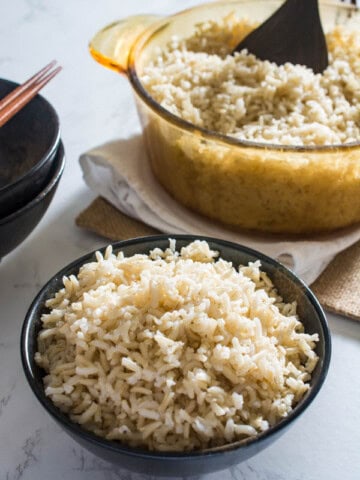
Nick says
Thanks for this informative post! I have recently gotten into cooking with carbon steel and I am stuck on the issue of acids and wok seasoning. I have noticed that many traditional stir frys include vinegar in their sauce, which is an acid!
I would like to cook stir frys using my wok. If I wait to use vinegar until my wok is very well seasoned, add the vinegar as late as possible, mix it with other ingredients first, and rinse out the pan right away, will that be enough? Or should I use another pan entirely for mixing it together?
Char says
Hi Nick! The amount of vinegar in most sauces is quite minimal so I wouldn't stress about that. In most cases, you would add the sauce towards the end anyways. If you find that it affects the wok's ability to create that nice patina, just re-season it as often as you need to. Hope that helps! Happy cooking!
Cherie says
Thank you for the great information. I just finished seasoning my new wok and I am excited to start using it.
Char says
You're so welcome, Cherie! Enjoy your new wok! 🙂
James says
Thank you so much for this post! I had a question: my wok did not change color at all over heat, does this mean I didn't do it right, or that I have the wrong kind of wok?
Char says
Hi James! Do you know what material is your wok made of? I wouldn't worry about the color not changing. However, if you have a stainless steel wok, you do not need to season it in this way. This seasoning method is only for cast iron and carbon steel woks. Feel free to reach out if you have any further questions!
Bob says
Is there a difference in the taste of food prepared using a:
1. carbon steel wok *seasoned),
2. cast iron wok (seasoned), or
3. stainless steel wok?
Bob
Char says
Hi Bob! The difference in flavor, if any, will be super subtle and will also depend on how well your carbon steel/cast iron wok is seasoned, and also what foods you had cooked in those woks to season them. I hope this helps!
Roy says
hello . thank you for on how to season a wok . very good information .
Char says
You're very welcome, Roy!